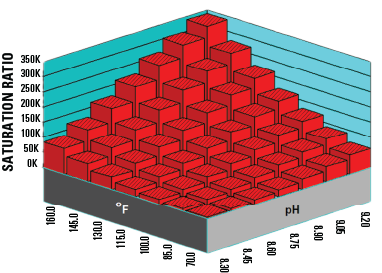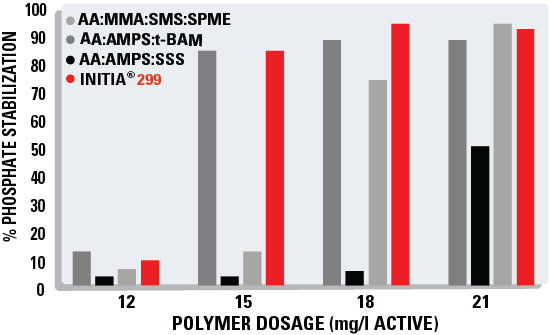
overview
INITIA® 299 is an optimized copolymer containing carboxylate, sulfonate and non-ionic monomers which is designed to outperform competitive industry polymers for calcium phosphate stabilization and the control of transition metal ions such as iron, zinc, and manganese. INITIA® 299 is set apart from competitive polymers by containing the highest level of sulfonate monomer functionality in its class. Sulfonated monomers are known to provide targeted functionality for calcium phosphate and metals stabilization. Additionally, INITIA® 299 has been designed with an optimized molecular weight and non-ionic monomer selection and concentration. These parameters enhance performance for targeted deposits and provide enhanced particulate dispersion functionality. INITIA® 299 is an effective calcium carbonate inhibitor and has exceptional stability in stressed water applications. INITIA® 299 can be paired with HEDP in low to moderate LSI (0 – <2.0) applications or PBTC in high LSI (> 2.0) applications to enhance deposit control properties for calcium carbonate.
typical properties
| appearance | slightly hazy, pale straw liquid |
| total solid content | 44.0 – 46.0 % |
| pH (as is) | 2.5 – 4.0 |
| Brookfield viscosity at 25 °C | < 500 cPs |
| density at 20 °C | 1.17 +/- 0.05 g/ml |
| residual monomer | <0.1% |
INITIA® 299 delivers…
- highest sulfonate content in class
- tailored molecular weight and non-ionic content
- superior calcium phosphate stabilization
- best-in-class transition metals stabilization
- exceptional particulate dispersion
- effective carbonate control to LSI 2.0 – 2.5
suggested applications
- reuse waters
- cooling towers
- boilers
- mining
- oilfield and natural gas
calcium phosphate stabilization
INITIA® 299 has been thoroughly evaluated versus competitive industry materials including industry leading copolymer, terpolymer, and tetrapolymer technologies. Testing was conducted in severe service conditions for calcium phosphate with the following test parameters: 500 mg/l calcium (as CaCO3), 10 mg/l phosphate (as PO43-), 2 mg/l ferrous iron, temperature 158 degrees Fahrenheit, and filtration through a 0.45 micron membrane after holding time of 18 hours. Graph 1 shows the severity of the evaluation methodology via WaterCycle® 3-D visual chemistry® graph where under the test conditions ori-calcium phosphate saturation exceeds 250,000X
graph 1 – WaterCycle® 3-D calcium phosphate saturation pH and Time

INITIA® 299 is an advanced copolymer that incorporates carboxylate, sulfonate, and non-ionic monomers that has been designed with an optimized molecular weight. INITIA® 299 is distinctly designed to outperform competitive industry polymers for calcium phosphate stabilization and the control of transition metal ions such as iron, zinc, and magnesium. INITIA® 299 is set apart from competitive polymers by its composition of the highest level of sulfonate monomer functionality in its class. Sulfonated monomers are known to provide exceptional targeted functionality for calcium phosphate and metals stabilization. These specifically chosen parameters elevate its performance for targeted deposits and bolster its ability to facilitate superior particulate dispersion. Graph 2 provides comparison of INITIA® 299 to both 75:25 w/w% and 60:40 w/w% copolymers of AA:AMPS. Graph 3 demonstrates the efficacy of INITIA® 299 versus terpolymer and tetrapolymer technologies. Testing was conducted in severe service conditions for calcium phosphate with the following test parameters: 500 mg/l calcium (as CaCO3), 10 mg/l phosphate (as PO43-), 2 mg/l ferrous iron, temperature 158 degrees Fahrenheit, and filtration through a 0.45 micron membrane after holding time of 18 hours.
graph 2 – INITIA® 299 calcium phosphate saturation vs AA:AMPS Copolymers

graph 3 – INITIA® 299 calcium phosphate saturation vs terpolymers and tetrapolymers

safety use and handling
Consult the Safety Data Sheet (SDS) for further information regarding the safe handling and use of INITIA® 299. This product should be stored in a cool/dry place and must be protected from freezing. Avoid storage at high temperatures (>90°F), direct sunlight, and exposure to surface, airborne or other common environmental contaminants such as debris, bacteria, yeast, and mold.